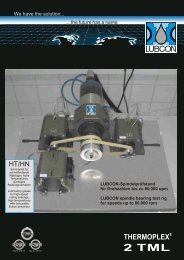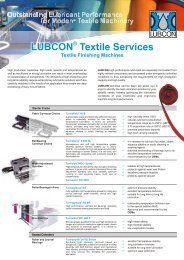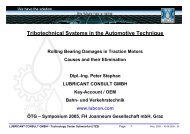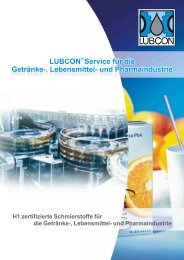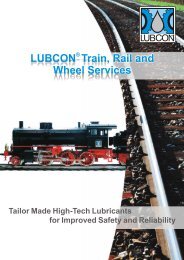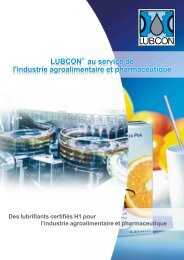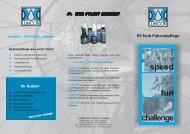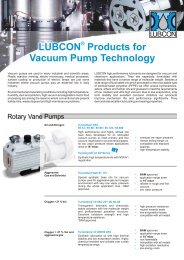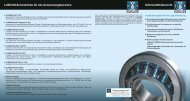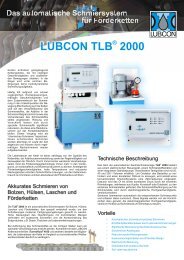TURMOGREASE Li 802 EP - Lubricant Consult GmbH
TURMOGREASE Li 802 EP - Lubricant Consult GmbH
TURMOGREASE Li 802 EP - Lubricant Consult GmbH
You also want an ePaper? Increase the reach of your titles
YUMPU automatically turns print PDFs into web optimized ePapers that Google loves.
®<br />
<strong>TURMOGREASE</strong> <strong>Li</strong> <strong>802</strong> <strong>EP</strong><br />
Determination of the Application Range<br />
The upper limit of the service temperature range was derived<br />
from the result of the FAG FE9 test run according to DIN 51821 at<br />
+140 °C with an operating time of F 50 = 200 hours, see<br />
diagram 2, p. 6.<br />
A good standard grease on lithium base renders only a time of<br />
F 50 = 147 h at a temperature of +120 °C. Therefore, the appli-<br />
®<br />
cation temperature of <strong>TURMOGREASE</strong> <strong>Li</strong> <strong>802</strong> <strong>EP</strong> is by 20 °C<br />
higher than that of a usual standard grease.<br />
The lower temperature limit was deducted from the flow<br />
pressure at -35 °C specified in DIN 51805.<br />
Owing to the low flow pressure of 1380 hPa as determined in the<br />
DIN test, relubrication is still possible at -35 °C.<br />
The defined rolling bearing application range is based on<br />
results of the FAG FE8 test:<br />
At a low rotating speed and a high load the specified 500<br />
operating hours were achieved without any failures and with<br />
only very little wear of bearing elements. This test was carried<br />
out with angular contact ball bearings at temperatures from<br />
+30 °C up to +40 °C as well as with taper roller bearings at a<br />
temperature of +60 °C. The detailed test results are shown in<br />
the diagrams 3 and 4, p. 7.<br />
The higher speed range was tested at speeds near the upper<br />
limit of the admissible speed factor using angular contact ball<br />
bearings at temperatures from +90 °C up to +120 °C, the result<br />
is shown in the diagram 5, p. 8, as well as taper roller bearings<br />
at +90 °C up to +120 °C, the result is shown in diagram 6, p. 8.<br />
®<br />
Table 1: Technical Data of <strong>TURMOGREASE</strong> <strong>Li</strong> <strong>802</strong> <strong>EP</strong><br />
Technical Data<br />
Colour<br />
Thickener<br />
2<br />
Base oil viscosity +40 °C/+100 °C (mm /s)<br />
Drop point (°C)<br />
Worked penetration 60 TT (mm/10)<br />
Water resistance +90 °C<br />
SKF Emcor Corrosion protection<br />
Oxidation resistance 100 h/+100 °C (bar)<br />
Copper corrosion +120 °C<br />
Flow pressure at -35 °C (hPa)<br />
Oil separation (% by wt.) +40 °C/+100 °C<br />
Content of solid matters, particles 25 µm (mg)<br />
Behaviour towards NBR elastomer, 7 days at +100 °C<br />
Change of Shore A hardness 15 SAH<br />
Tearing elongation 150 %<br />
Change of volume max. 10 %<br />
PA66-GF25 42 days at +120 °C<br />
2<br />
Tearing strength 130 N/mm<br />
Tearing elongation 2 %<br />
2<br />
Impact tenacity 20 mJ/mm<br />
4<br />
The test runs were evaluated by comparing the wear results with<br />
the requirements for lubricating greases of the FAG grease<br />
classification (= FAG specification).<br />
For the evaluation it was decisive that the 500 hour tests were<br />
completed without failures and that wear was only moderate.<br />
All test runs were repeated several times, i. e. the results can be<br />
considered reliable.<br />
Even though these were short-period tests, they clearly showed<br />
®<br />
that the suitability of <strong>TURMOGREASE</strong> <strong>Li</strong> <strong>802</strong> <strong>EP</strong> for the<br />
indicated application range is above average.<br />
Satisfactory operational results can be expected, when observing<br />
the indicated lubricating intervals. The test speed<br />
differed from the speed factor, due to the test bench; the higher<br />
speed factor was choosen as a result of referring field experiences.<br />
Friction Behaviour<br />
The friction behaviour was tested on an FAG R6 test rig.<br />
Diagram 7, p. 9 shows the test results, whereby the quick<br />
distribution of grease is remarkable. This becomes obvious by<br />
the early reduction of friction over the running time.<br />
The low friction in the steady-state condition and the moderate<br />
loss of grease show that this product is suitable for sealed and<br />
shielded bearings.<br />
®<br />
<strong>TURMOGREASE</strong> <strong>Li</strong> <strong>802</strong> <strong>EP</strong><br />
brown<br />
<strong>Li</strong>thium soap<br />
Mineral/Synth. 85/12.5<br />
190<br />
265 - 295<br />
1 - 90<br />
0 - 0<br />
0.4<br />
Rating 1<br />
1380<br />
approx. 3.5/6<br />
< 5<br />
+2 SAH<br />
-19.8 %<br />
-3.4 %<br />
2<br />
184 N/mm<br />
+18.8 %<br />
2<br />
-17.8 mJ/mm<br />
proved acc. to<br />
DIN 51562<br />
DIN ISO 2176<br />
DIN ISO 2137<br />
DIN 51807T1<br />
DIN 51<strong>802</strong><br />
DIN 51808<br />
DIN 51811<br />
DIN 51805<br />
DIN 51817<br />
DIN 51813<br />
DIN 53505<br />
DIN 53504<br />
DIN 53521<br />
DIN EN 61<br />
DIN EN 61<br />
DIN 53453



